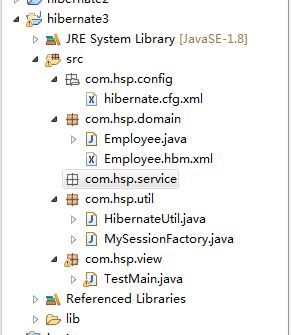手动配置hibernate的全过程
主流的数据库是关系型数据库,而编程的思想是面向对象的,如何将对象存储到关系型的数据库中,消除对象—>关系的阻抗,ORM(Object Relation Model)对象关系模型就出现了,而hibernate就是基于ORM的框架.下面我来聊聊hibernate的手动配置过程.
配置环境:eclipse,mysql数据库,hibernate的jar包和连接mysql数据库用的jar包.
配置前提:在mysql数据库中,名字为sqdb3的数据库,有一个叫employee的表.表的字段创建入下:
use spdb3;
create table employee(
id int PRIMARY key auto_increment,
username varchar(64) not null,
email varchar(64) not null,
hiredate date not null
);employee表里面的内容自己可以随意添加.
配置的思想是先建立一个POJO对象,配置Employee.hbm.xml文件,最后配置hibernate.cfg.xml文件.先展示一下各个文件所在的位置.
①先解释一下POJO的作用,它是一个类(对象类),它所用拥有的属性对应的是表中的字段,方法是set/get属性.用来映射employee.Employee.java的代码如下:
package com.hsp.domain;
import java.util.*;
import java.io.*;
//建议我们的domain对象的名称就是对应
//表的首字母大写,domain对象/javaBean/pojo
//该pojo按规范应当序列化,目的是可以唯一的标识该对象,同时可以在网络和文件上传输
public class Employee implements Serializable{
static final long serialVersionUID=1L;
private Integer id;
private String username;
private String email;
private Date hiredate;
public Integer getId() {
return id;
}
public void setId(Integer id) {
this.id = id;
}
public String getUsername() {
return username;
}
public void setUsername(String username) {
this.username = username;
}
public String getEmail() {
return email;
}
public void setEmail(String email) {
this.email = email;
}
public Date getHiredate() {
return hiredate;
}
public void setHiredate(Date hiredate) {
this.hiredate = hiredate;
}
}②在与POJO同一个目录下的Employee.hbm.xml文件其实是一个对象关系映射文件.内容如下:
<hibernate-mapping package="com.hsp.domain">
<class name="Employee" lazy="true" table="employee">
<id name="id" type="java.lang.Integer">
<column name="id"/>
<generator class="identity"/>
id>
<property name="username" type="java.lang.String">
<column name="username" not-null="false" />
property>
<property name="email" type="java.lang.String">
<column name="email" not-null="false">column>
property>
<property name="hiredate" type="java.util.Date">
<column name="hiredate" not-null="false">column>
property>
class>
hibernate-mapping>让我来简单解释一下这个Employee.hbm.xml文件的内容,
package="com.hsp.domain">
<class name="Employee" lazy="true" table="employee"> 这个是将对象类(Employee)和表(employee)对应起来,其中lazy表示的是懒加载,这个作用之后在解释.
<id name="id" type="java.lang.Integer">
name="id"/>
class="identity"/>
id> id这个字段是用来唯一表示表中的主键的属性,name表示的其实就是Employee.java中的属性,type表示它的类型,column对应的是表中的那个字段.
③下面重头戏闪亮登场.hibernate.cfg.xml文件
内容如下:
<hibernate-configuration>
<session-factory name="mySessionFactory">
<property name="hibernate.connection.driver_class">com.mysql.jdbc.Driverproperty>
<property name="hibernate.connection.url">jdbc:mysql://localhost:3306/spdb3property>
<property name="hibernate.connection.username">rootproperty>
<property name="connection.password">rootproperty>
<property name="hibernate.dialect">org.hibernate.dialect.MySQLDialectproperty>
<property name="connection.pool_size">2property>
<property name="hibernate.hbm2ddl.auto">updateproperty>
<property name="show_sql">trueproperty>
<property name="format_sql">trueproperty>
<mapping resource="com/hsp/domain/Employee.hbm.xml" />
session-factory>
hibernate-configuration>这个文件的作用其实就是配置你所使用的数据库,url,user,passwd,方言等.在这个文件中的参数有很多,我所了解的只是皮毛,大家可以看看代码中的注释.
④我自己还写了一个获得直接获得Session的静态的方法.HibernateUtil.java.内容如下
package com.hsp.util;
import org.hibernate.Session;
import org.hibernate.SessionFactory;
import org.hibernate.cfg.Configuration;
final public class HibernateUtil {
private static SessionFactory sessionFactory=null;
//使用线程局部模式
private static ThreadLocal threadLocal=new ThreadLocal();
//私有的构造函数
private HibernateUtil() {};
static {
sessionFactory=new Configuration().configure("com/hsp/config/hibernate.cfg.xml").buildSessionFactory();
}
//获取全新的session
public static Session openSession() {
return sessionFactory.openSession();
}
//获取和线程关联的session
public static Session getCurrentSession() {
Session session=threadLocal.get();
//判断是否得到
if(session==null) {
session=sessionFactory.openSession();
//把session对象设置到threadLocal,相当于该session已经和线程绑定
threadLocal.set(session);
}
return session;
}
} 在这个类中有两个静态的方法,其中openSession()方法是直接获得一个session,getCurrentSession()方法是获得一个线程安全的session(有利于事务的处理).他们之间的具体差别我就不详细解释了.
⑤.下面就是一个Test.java这个的作用就是来验证是否可以用hibernate框架来进行crud操作
package com.hsp.util;
import java.util.Date;
import java.util.List;
import com.hsp.util.*;
import org.hibernate.Query;
import org.hibernate.Session;
import org.hibernate.SessionFactory;
import org.hibernate.Transaction;
import org.hibernate.cfg.*;
import com.hsp.domain.Employee;
public class TestMain {
public static void main(String[] args) {
//获取session
Session session =HibernateUtil.getCurrentSession();
//事务
Transaction ts = null;
try {
//事务处理
ts = session.beginTransaction();
// do...
Employee emp = (Employee) session.load(Employee.class, 1);
//修改id为1的username
emp.setUsername("dddd");
// ....doing
//事务提交
ts.commit();
} catch (Exception e) {
//如果出错,回滚数据
if (ts != null) {
ts.rollback();
}
throw new RuntimeException(e.getMessage());
} finally {
// 关闭session
if (session != null && session.isOpen()) {
session.close();
}
}
}
}ok,在这里给初学者普及一下事务这个概念.比如银行转转,你从农行的一个账户中向工行的一个账户转钱,其业务是这样的,农行账户的钱减去100,工行账户的钱加100,这需要操作数据库,将减钱和加钱的操作同时进行完成.不能减钱完成,加钱没完成或反之这就需要事务了.它将这两操作包裹成原子操作.要么做完,要么不做.当只是执行其中一个的时候,就回滚(相当于不做).